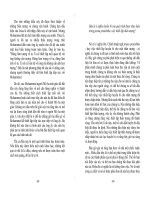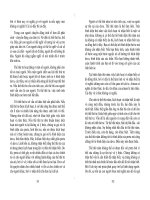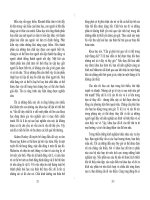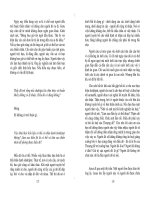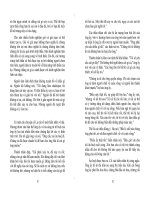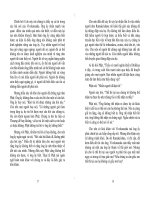2009 james e burt gerald m barber david l rigby elementary statistics for geographers the guilford press (2009)
Bạn đang xem bản rút gọn của tài liệu. Xem và tải ngay bản đầy đủ của tài liệu tại đây (10.78 MB, 669 trang )
ebook
THE GUILFORD PRESS
Elementary Statistics for Geographers
Elementary Statistics
for Geographers
Third Edition
JAMES E. BURT
GERALD M. BARBER
DAVID L. RIGBY
THE GUILFORD PRESS
New York London
© 2009 The Guilford Press
A Division of Guilford Publications, Inc.
72 Spring Street, New York, NY 10012
www.guilford.com
All rights reserved
No part of this book may be reproduced, translated, stored in a retrieval system, or
transmitted, in any form or by any means, electronic, mechanical, photocopying,
microfilming, recording, or otherwise, without written permission from the Publisher.
Printed in the United States of America
This book is printed on acid-free paper.
Last digit is print number: 9
8 7 6 5 4 3 2 1
Library of Congress Cataloging-in-Publication Data
Burt, James E.
Elementary statistics for geographers / James E. Burt, Gerald M. Barber,
David L. Rigby. — 3rd ed.
p. cm.
Includes bibliographical references and index.
ISBN 978-1-57230-484-0 (hardcover)
1. Geography—Statistical methods. I. Barber, Gerald M. II. Rigby, David L.
III. Title.
G70.3.B37 2009
519.5024′91—dc22
2008043409
Preface
Readers who know our book will quickly see that this edition represents a significant
revision, containing both a substantial amount of new material and extensive reorganization of topics carried over from the second edition. However, our purpose remains
unchanged: to provide an accessible algebra-based text with explanations that rely on
fundamentals and theoretical underpinnings. Such an emphasis is essential if we expect students to utilize statistical methods in their own research or if we expect them
to evaluate critically the work of others who employ statistical methods. In addition,
when students understand the foundation of the methods that are covered in a first
course, they are far better equipped to handle new concepts, whether they encounter
those concepts in a more advanced class or through reading on their own. We acknowledge that undergraduates often have a limited mathematical background, but
we do not believe this justifies a simplified approach to the subject, nor do we think
that students are well served by learning what is an inherently quantitative subject
area without reference to proofs and quantitative arguments. It is often said that
today’s entering students are less numerate than previous generations. That may be.
However, in our 20-plus years of teaching undergraduates we have seen no decrease
in their ability or in their propensity to rise to an intellectual challenge. Like earlier
versions, this edition of Elementary Statistics for Geographers is meant for instructors who share this outlook, and for their students, who—we trust—will benefit from
that point of view.
The Descriptive Statistics section of this edition greatly expands the coverage
of graphical methods, which now comprise a full chapter (Chapter 2). This reflects
new developments in computer-generated displays in statistics and their growing use;
also, students increasingly seem oriented toward visual learning. It is likely, for example, that a student who obtains a good mental image of skewness from Chapter 2
can use that visual understanding to grasp more readily the quantitative measures
presented in Chapter 3. A second new chapter appearing in the descriptive section is
Chapter 4, Statistical Relationships. It introduces both concepts of and measures for correlation and regression. This is somewhat nonstandard, in that most books postpone
these topics until after the discussion of univariate methods. We have found that earlier
v
vi
PREFACE
introduction of this material has several advantages. First, correlation and regression
are large topics, and some students do better learning them in two parts. Second, the
concept of association is useful when explaining certain aspects of probability theory
such as independence, conditional probability, and joint probability. Finally, it is easier
to discuss nonparametric tests such as chi-square when the idea of statistical association has already been presented. Of course, instructors who prefer to cover correlation and regression in one section of their course can postpone Chapter 4 and cover
it as part of a package with Chapters 12 and 13.
The Inferential Statistics section has also been heavily revised. We merged
basic probability theory with the treatment of random variables to create more streamlined coverage in a single chapter (Chapter 5, Random Variables and Probability Distributions). Gone is the Computer-Intensive Methods chapter, with much of that
material incorporated into the Nonparametric Methods chapter. As bootstrapping and
related techniques have become mainstream, it is appropriate to locate them in their
natural home with other nonparametric methods. Chapter 11, Analysis of Variance, is
a new chapter, which covers both single- and two-factor designs. Also new is Chapter 13, Extending Regression Analysis, which treats diagnostics as well as transformations and more advanced regression models (including multiple regression).
The last section, Patterns in Space and Time, contains a revised version of the
Time Series Analysis chapter from the second edition, and the entirely new Chapter 14,
Spatial Patterns and Relationships. The latter is an overview of spatial analysis, and
covers point patterns (especially nearest neighbor analysis), spatial autocorrelation
(variograms, join counts, Moran’s I, LISA, and G-statistics), and spatial regression
(including an introduction to geographically weighted regression).
Additionally, there are lesser changes too numerous to itemize. We’ve placed
greater emphasis on worked examples, often with accompanying graphics, and the
datasets that we refer to throughout the book are available on the website that accompanies this book. On the website, readers can also find answers to most of the
end-of-chapter exercises. See www.guilford.com/pr/burt for the online resources.
We have said already that this new edition adheres to the previous editions’ emphasis on explanation, rather than mere description, in its presentation of quantitative
methods. Several other aspects are also unchanged. We have retained the coverage of
time series, which of course is seldom covered in this type of book. Time series data
are extremely common in all branches of geography; thus, geographers need to be
equipped with at least a few tools of analysis for temporal data. Also, once students
get to linear regression, they are well positioned to understand the basics of time series modeling. In other words, ability to handle time series can be acquired at little
additional cost. Because time series are so common, geographers will likely have
occasion to deal with temporal data regardless of their formal training in the subject.
We believe that even simple operations like running means should not be undertaken
by individuals who do not appreciate the implications of the procedure. Because most
students will not take a full course in time series, minimal coverage, at least, is essential in an introductory text. Also, we’ve received strong positive feedback on this
material from instructors.
PREFACE
vii
We have continued our practice from the second edition, of not tying the book
to any particular software package. We believe that most instructors use software for
teaching this material, but no package has emerged as an overwhelming favorite. We
might gain a friend by gearing the book to a particular package, but we would alienate half a dozen more. Also, since statistical software is becoming increasingly easy
to use, students require less in the way of instruction. And we want the book to stay
current. We have found that even minor changes in the formatting of output can confound students who have been directed to look for particular tables of values or particular terminology in software packages.
Finally, in keeping with the trend from edition to edition, what was a long book
is even longer. Unless it is used in a year-long course, instructors will have to be very
selective with regard to what they assign. With this in mind, we have attempted to
make the chapters as self-contained as possible. Except for the chapter on probability and sampling theory, a “pick-and-choose” approach will work reasonably well. For
example, we know from experience that some instructors leave out the Nonparametric
Methods chapter altogether, with no downstream effects, whereas others skip various
chapters and subsections within chapters. If some students complain about having to
skip around so much, most appreciate a book that covers more than what is taught in
the course. Later, when confronted with an unfamiliar method in readings or on a research project, they can return to a book whose notational quirks have already been
mastered, and can understand the new technique in context with what was presented
in the course. As we reflect on our own bookshelves, it is precisely that kind of book
that has proved most useful to us over the years. We wouldn’t presume to claim that
our work will have similar lasting utility, but we offer it in the belief that it is better
to cover too much than too little.
Many people deserve our thanks for their help in preparing this book. We are
particularly grateful to students and teaching assistants at UCLA, Queen’s University,
and the University of Wisconsin–Madison for telling us what worked and what didn’t.
Thanks also to the panel of anonymous reviewers for their comments on previous versions of the manuscript. You improved it greatly. We also very much appreciate the
hard work by everyone at The Guilford Press involved with the project, especially our
editor, the ever-patient and encouraging Kristal Hawkins. Our production editor
William Meyer also deserves particular mention for his careful attention to both the
print and digital components of the project. Most of all, we thank our families for so
willingly accepting the cost of our preoccupation. To them we dedicate the book.
Contents
I. INTRODUCTION
1. Statistics and Geography
1.1. Statistical Analysis and Geography
1.2. Data
1.3. Measurement Evaluation
1.4. Data and Information
1.5. Summary
3
8
16
28
31
33
II. DESCRIPTIVE STATISTICS
2. Displaying and Interpreting Data
2.1. Display and Interpretation of the Distributions
of Qualitative Variables
2.2. Display and Interpretation of the Distributions
of Quantitative Variables
2.3. Displaying and Interpreting Time-Series Data
2.4. Displaying and Interpreting Spatial Data
2.5. Summary
3. Describing Data with Statistics
3.1. Measures of Central Tendency
3.2. Measures of Dispersion
3.3. Higher Order Moments or Other Numerical Measures
of the Characteristics of Distributions
3.4. Using Descriptive Statistics with Time-Series Data
3.5. Descriptive Statistics for Spatial Data
3.6. Summary
39
41
46
74
79
92
95
95
109
117
118
124
147
ix
x
CONTENTS
Appendix 3a. Review of Sigma Notation
Appendix 3b. An Iterative Algorithm for Determining the Weighted
or Unweighted Euclidean Median
4. Statistical Relationships
4.1. Relationships and Dependence
4.2. Looking for Relationships in Graphs and Tables
4.3. Introduction to Correlation
4.4. Introduction to Regression
4.5. Temporal Autocorrelation
4.6. Summary
Appendix 4a. Review of the Elementary Geometry of a Line
Appendix 4b. Least Squares Solution via Elementary Calculus
148
150
156
157
158
164
172
188
191
192
194
III. INFERENTIAL STATISTICS
5. Random Variables and Probability Distributions
5.1. Elementary Probability Theory
5.2. Concept of a Random Variable
5.3. Discrete Probability Distribution Models
5.4. Continuous Probability Distribution Models
5.5. Bivariate Random Variables
5.6. Summary
Appendix 5a. Counting Rules for Computing Probabilities
Appendix 5b. Expected Value and Variance of a Continuous
Random Variable
201
201
210
220
233
238
246
246
6. Sampling
6.1. Why Do We Sample?
6.2. Steps in the Sampling Process
6.3. Types of Samples
6.4. Random Sampling and Related Probability Designs
6.5. Sampling Distributions
6.6. Geographic Sampling
6.7. Summary
254
256
257
260
262
271
282
289
7. Point and Interval Estimation
7.1. Statistical Estimation Procedures
7.2. Point Estimation
7.3. Interval Estimation
7.4. Sample Size Determination
7.5. Summary
293
294
300
303
315
318
250
CONTENTS
xi
8. One-Sample Hypothesis Testing
8.1. Key Steps in Classical Hypothesis Testing
8.2. PROB-VALUE Method of Hypothesis Testing
8.3. Hypothesis Tests Concerning the Population Mean μ and π
8.4. Relationship between Hypothesis Testing and Confidence
Interval Estimation
8.5. Statistical Significance versus Practical Significance
8.6. Summary
321
321
333
338
345
345
349
9. Two-Sample Hypothesis Testing
9.1. Difference of Means
9.2. Difference of Means for Paired Observations
9.3. Difference of Proportions
9.4. The Equality of Variances
9.5. Summary
353
354
363
367
369
373
10. Nonparametric Methods
10.1. Comparison of Parametric and Nonparametric Tests
10.2. One- and Two-Sample Tests
10.3. Multisample Kruskal–Wallis Test
10.4. Goodness-of-Fit Tests
10.5. Contingency Tables
10.6. Estimating a Probability Distribution: Kernel Estimates
10.7. Bootstrapping
10.8. Summary
376
377
380
393
395
405
408
418
427
11. Analysis of Variance
11.1. The One-Factor, Completely Randomized Design
11.2. The Two-Factor, Completely Randomized Design
11.3. Multiple Comparisons Using the Scheffé Contrast
11.4. Assumptions of the Analysis of Variance
11.5. Summary
Appendix 11a. Derivation of Equation 11-11
from Equation 11-10
432
434
446
453
455
457
12. Inferential Aspects of Linear Regression
12.1. Overview of the Steps in a Regression Analysis
12.2. Assumptions of the Simple Linear Regression Model
12.3. Inferences in Regression Analysis
12.4. Graphical Diagnostics for the Linear Regression Model
12.5. Summary
461
461
465
476
488
495
457
xii
13. Extending Regression Analysis
13.1. Multiple Regression Analysis
13.2. Variable Transformations and the Shape
of the Regression Function
13.3. Validating a Regression Model
13.4. Summary
CONTENTS
498
498
514
525
528
IV. PATTERNS IN SPACE AND TIME
14. Spatial Patterns and Relationships
14.1. Point Pattern Analysis
14.2. Spatial Autocorrelation
14.3. Local Indicators of Spatial Association
14.4. Regression Models with Spatially Autocorrelated Data
14.5. Geographically Weighted Regression
14.6. Summary
533
533
544
559
566
570
571
15. Time Series Analysis
15.1. Time Series Processes
15.2. Properties of Stochastic Processes
15.3. Types of Stochastic Processes
15.4. Removing Trends: Transformations to Stationarity
15.5. Model Identification
15.6. Model Fitting
15.7. Times Series Models, Running Means, and Filters
15.8. The Frequency Approach
15.9. Filter Design
15.10. Summary
577
578
579
584
588
590
595
601
603
609
616
Appendix: Statistical Tables
621
Index
643
About the Authors
653
Elementary Statistics for Geographers
I
INTRODUCTION
1
Statistics and Geography
Most of us encounter probability and statistics for the first time through radio, television, newspapers, or magazines. We may see or hear reports of studies or surveys
concerning political polls or perhaps the latest advance in the treatment of cancer or
heart disease. If we were to reflect on it for a moment, we would probably notice that
statistics is used in almost all fields of human endeavor. For example, many sports organizations keep masses of statistics, and so too do many large corporations. Many
companies find that the current production and distribution systems within which
they operate require them to monitor their systems leading to the collection of large
amounts of data. Perhaps the largest data-gathering exercises are undertaken by governments around the world when they periodically complete a national census.
The word “statistics” has another more specialized meaning. It is the methodology for collecting, presenting, and analyzing data. This methodology can be used
as a basis for investigation in such diverse academic fields as education, physics and
engineering, medicine, the biological sciences, and the social sciences including geography. Even traditionally nonquantitative disciplines in the humanities are finding
increasing uses for statistical methodology.
DEFINITION: STATISTICS
Statistics is the methodology used in studies that collect, organize, and summarize data through graphical and numerical methods, analyze the data, and
ultimately draw conclusions.
Many students are introduced to statistics so that they can interpret and understand
research carried out in their field of interest. To gain such an understanding, they
must have basic knowledge of the procedures, symbols, and vocabulary used in these
studies.
No matter which discipline utilizes statistical methodology, analysis begins with
the collection of data. Analysis of the data is then usually undertaken for one of the
following purposes:
3
4
INTRODUCTION
1. To help summarize the findings of some inquiry, for example, a study of the
travel behavior of elderly or handicapped citizens or the estimation of timber reforestation requirements.
2. To obtain a better understanding of the phenomenon under study, primarily
as an aid in generalization or theory validation, for example, to validate a
theory of urban land rent.
3. To make a forecast of some variable, for example, short-term interest rates,
voter behavior, or house prices.
4. To evaluate the performance of some program, for example, a particular
form of diet, or an innovative medical or educational program or reform.
5. To help select a course of action among a set of possible alternatives, or to
plan some system, for example, school locations.
That elements of statistical methodology can be used in such a variety of situations
attests to its impressive versatility.
It is convenient to divide statistical methodology into two parts: descriptive statistics and inferential statistics. Descriptive statistics deals with the organization and
summary of data. The purpose of descriptive statistics is to replace what may be an
extremely large set of numbers in some dataset with a smaller number of summary
measures. Whenever this replacement is made, there is inevitably some loss of information. It is impossible to retain all of the information in a dataset using a smaller
set of numbers. One of the principal goals of descriptive statistics is to minimize the
effect of this information loss. Understanding which statistical measure should be
used as a summary index in a particular case is another important goal of descriptive
statistics. If we understand the derivation and use of descriptive statistics and are
aware of its limitations, we can help to avoid the propagation of misleading results.
Much of the distrust of statistical methodology derives from its misuse in studies
where it has been inappropriately applied or interpreted. Just as the photographer can
use a lens to distort a scene, so can a statistician distort the information in a dataset
through his or her choice of summary statistics. Understanding what descriptive statistics can tell us, as well as what it cannot, is a key concern of statistical analysis.
In the second major part of statistical methodology, inferential statistics, descriptive statistics is linked with probability theory so that an investigator can generalize the results of a study of a few individuals to some larger group. To clarify this
process, it is necessary to introduce a few simple definitions. The set of persons, regions, areas, or objects in which a researcher has an interest is known as the population for the study.
DEFINITION: STATISTICAL POPULATION
A statistical population is the total set of elements (objects, persons, regions,
neighborhoods, rivers, etc.) under examination in a particular study.
For instance, if a geographer is studying farm practices in a particular region, the
relevant population consists of all farms in the region on a certain date or within a
S TAT I S T I C S A N D G E O G R A P H Y
5
certain time period. As a second example, the population for a study of voter behavior in a city would include all potential voters; these people are usually contained in an
eligible voters list.
In many instances, the statistical population under consideration is finite; that
is, each element in the population can be listed. The eligible voters lists and the assessment rolls of a city or county are examples of finite populations. At other times,
the population may be hypothetical. For example, a steel manufacturer wishing to test
the quality of output may select a batch of 100 castings over a few weeks of production. The population under study is actually the future set of castings to be produced
by the manufacturer using this equipment. Of course, this population does not exist
and may have an infinitely large number of elements. Statistical analysis is relevant
to both finite and hypothetical populations.
Usually, we are interested in one or more characteristics of the population.
DEFINITION: POPULATION CHARACTERISTIC
A population characteristic is any measurable attribute of an element in the
population.
A fluvial geomorphologist studying stream flow in a watershed may be interested in
a number of different measurable properties of these streams. Stream velocity, discharge, sediment load, and many other characteristic channel data may be collected
during a field study. Since a population characteristic usually takes on different values
for different elements of the population, it is usually called a variable. The fact that the
population characteristic does take on different values is what makes the process of
statistical inference necessary. If a population characteristic does not vary within the
population, it is of little interest to the investigator from an inferential point of view.
DEFINITION: VARIABLE
A variable is a population characteristic that takes on different values for the
elements comprising the population.
Information about a population can be collected in two ways. The first is to determine
the value of the variable(s) of interest for each and every element of the population.
This is known as a population census or population enumeration. Clearly, it is a feasible alternative only for finite populations. It is extremely difficult, some would argue even impossible, for large populations. It is unlikely that a national decennial
Census of Population in a large country actually captures all of the individuals in that
population, but the errors can be kept to a minimum if the enumeration process is well
designed.
DEFINITION: POPULATION CENSUS
A population census is a complete tabulation of the relevant population characteristic for all elements in the population.
6
INTRODUCTION
The second way information can be obtained about a population is through a sample.
A sample is simply a subset of a population, thus in sampling we obtain values for
only selected members of a population.
DEFINITION: SAMPLE
A sample is a subset of the elements in the population and is used to make inferences about certain characteristics of the population as a whole.
For practical considerations, usually time and/or cost, it is far more convenient to
sample rather than enumerate the entire population. Of course, sampling has one distinct disadvantage. Restricting our attention to a small proportion of the population
makes it impossible to be as accurate about population characteristics as is possible
with a complete census. The risk of making errors is increased.
DEFINITION: SAMPLING ERROR
Sampling error is the difference between the value of a population characteristic and the value of that characteristic inferred from a sample.
To illustrate sampling error, consider the population characteristic of the average
selling price of homes in a given metropolitan area in a certain year. If each and every
house is examined, it is found that the average selling price is $150,000. However, if
only 25 homes per month are sampled and the average selling price of the 300 homes
in the sample (12 months × 25 homes), the average selling price in the sample may be
$120,000. All other things being equal, we could say that the difference of $150,000 –
$120,000 = $30,000 is due to sampling error.
What do we mean by all other things being equal? Our error of $30,000 may
be partly due to factors other than sampling. Perhaps the selling price for one home in
the sample was incorrectly identified as $252,000 instead of $152,000. Many errors
of this type occur in large datasets. Information obtained from personal interviews
or questionnaires can contain factual errors from respondents owing to lack of recall,
ignorance, or simply the respondent’s desire to be less than candid.
DEFINITION: NONSAMPLING OR DATA ACQUISITION ERRORS
Errors that arise in the acquisition, recording, and editing of statistical data are
termed nonsampling or data acquisition errors.
In order that error, or the difference between the sample and the population can be
ascribed solely to sampling error, it is important to minimize nonsampling errors. Validation checks, careful editing, and instrument calibration are all methods used to reduce the possibility that nonsampling error will significantly increase the total error,
thereby distorting subsequent statistical inference.
The link between the sample and the population is probability theory. Inferences about the population are based on the information in the sample. The quality of
7
S TAT I S T I C S A N D G E O G R A P H Y
these inferences depends on how well the sample reflects, or represents, the population. Unfortunately, short of a complete census of the population, there is no way of
knowing how well a sample reflects the population. So, instead of selecting a representative sample, we select a random sample.
DEFINITION: REPRESENTATIVE SAMPLE
A representative sample is one in which the characteristics of the sample closely
match the characteristics of the population as a whole.
DEFINITION: RANDOM SAMPLE
A random sample is one in which every individual in the population has the
same chance, or probability, of being included in the sample.
Basing our statistical inferences on random samples ensures unbiased findings. It is
possible to obtain a very unrepresentative random sample, but the chance of doing so
is usually very remote if the sample is large enough. In fact, because the sample has
been randomly chosen, we can always determine the probability that the inferences
made from the sample are misleading. This is why statisticians always make probabilistic judgments, never deterministic ones. The inferences are always qualified to
the extent that random sampling error may lead to incorrect judgments.
The process of statistical inference is illustrated in Figure 1-1. Members, or
units, of the population are selected in the process of sampling. Together these units
comprise the sample. From this sample, whereas inferences about the population are
made. In short, sampling takes us from the population to a sample, statistical inference takes us from the sample back to the population. The aim of statistical inference
is to make statements about a population characteristic based on the information in a
sample. There are two ways of making inferences: estimation and hypothesis testing.
.....................
.....................
.....................
.....................
.....................
Population
Statistical
inference
Sampling
....
....
Sample
FIGURE 1-1. The process of statistical inference.
8
INTRODUCTION
DEFINITION: STATISTICAL ESTIMATION
Statistical estimation is the use of the information in a sample to estimate the
value of an unknown population characteristic.
The use of political polls to estimate the proportion of voters in favor of a certain party
or candidate is a well-known example of statistical estimation. Estimates are simply
the statistician’s best guess of the value of a population characteristic. From a random
sample of voters, we try and guess what proportion of all voters will support a certain candidate.
Through the second way of making inferences about a population characteristic, hypothesis testing, we hypothesize a value for some population characteristic and
then determine the degree of support for this hypothesized value from the data in our
random sample.
DEFINITION: HYPOTHESIS TESTING
Hypothesis testing is a procedure of statistical inference in which we decide
whether the data in a sample support a hypothesis that defines the value (or a
range of values) of a certain population characteristic.
As an example, we may wish to use a political poll to find out whether some
candidate holds an absolute majority of decided voters. Expressed in a statistical way,
we wish to know whether the proportion of voters who intend to vote for the candidate
exceeds a value of 0.50. We are not interested in the actual value of the population
characteristic (the candidate’s exact level of support), but in whether the candidate
is likely to get a majority of votes. As you might guess, these two ways of making
inferences are intimately related and differ more at the conceptual level. The relation
between them is so intimate that, for most purposes, both can be used to answer any
problem. No matter which method is used, there are two fundamental elements of any
statistical inference: the inference itself and a measure of our faith, or confidence in
it. A useful synopsis of statistical analysis, including both descriptive and inferential
techniques, is illustrated in Figure 1-2.
1.1. Statistical Analysis and Geography
The application of statistical methods to problems in geography is relatively new. Only
for about the last half-century has statistics been an accepted part of the academic
training of geographers. There are, however, earlier references to uses of descriptive
statistics in literature cited by geographers. For example, several 19th-century researchers, including H. C. Carey (1858) and E. G. Ravenstein (1885), used statistical
techniques in their studies of migration and other interactions. Elementary methods
of descriptive techniques are commonly seen in the geographical literature of the early
20th century. But for the most part, the three paradigms that dominated academic
9
S TAT I S T I C S A N D G E O G R A P H Y
Data
Collection
Process, organize, and
summarize the data by using
graphical techniques and
numerical indices
Descriptive
Statistics
Interpret the data
Are the data a census
or a sample?
Estimation
Sample
Hypothesis
testing
Inferential
Statistics
Census
Conclusions concerning the population
FIGURE 1-2. Statistical analysis.
geography in the first half of the 20th century—exploration, environmental determinism and possibilism, and regional geography—found few uses for statistical methods.
Techniques for statistical inference were emerging at this time but were not applied
in the geographical literature.
Exploration
This paradigm is one of the earliest used in geography. Unexplored areas of the earth
continued to hold the interest of geographers well into the current century. Explorations, funded by geographical societies such as the Royal Geographical Society
(RGS) and the American Geographical Society (AGS), continued the tradition of geographers collecting, collating, and disseminating information about relatively obscure
and unknown parts of the world. The research sponsored by these organizations helped
lead to the establishment of academic departments of geography at several universities.
But, given only a passing interest in generalization and an extreme concern for the
unique, little of the data generated by this research were ever analyzed by conventional statistical techniques.
Environmental Determinism and Possibilism
Environmental determinists and possibilists focused on the role of the physical environment as a controlling variable in explaining the diversity of the human impact on
